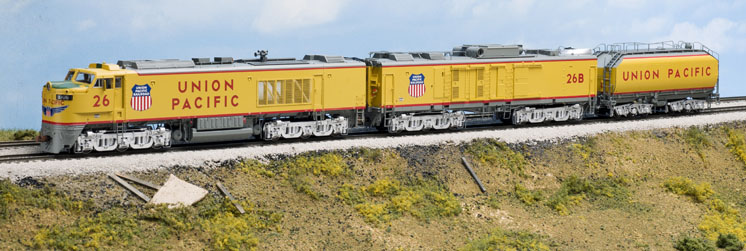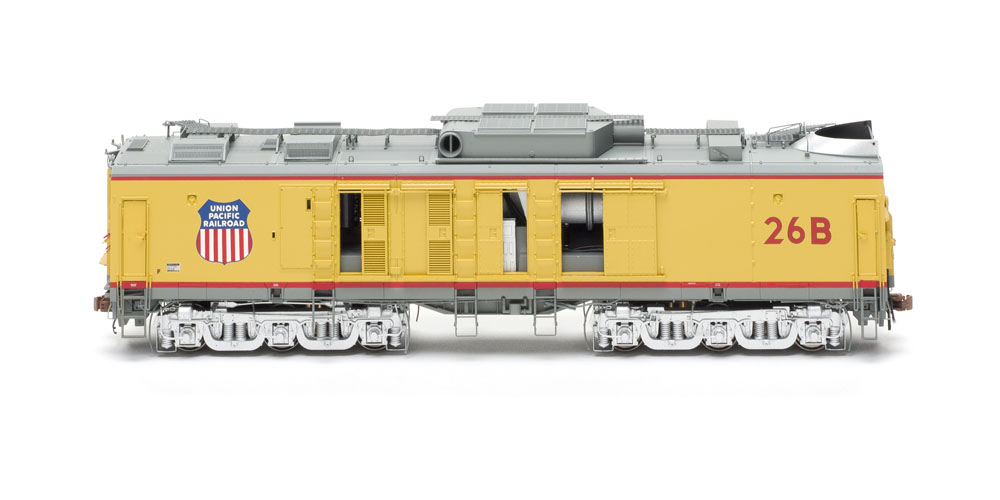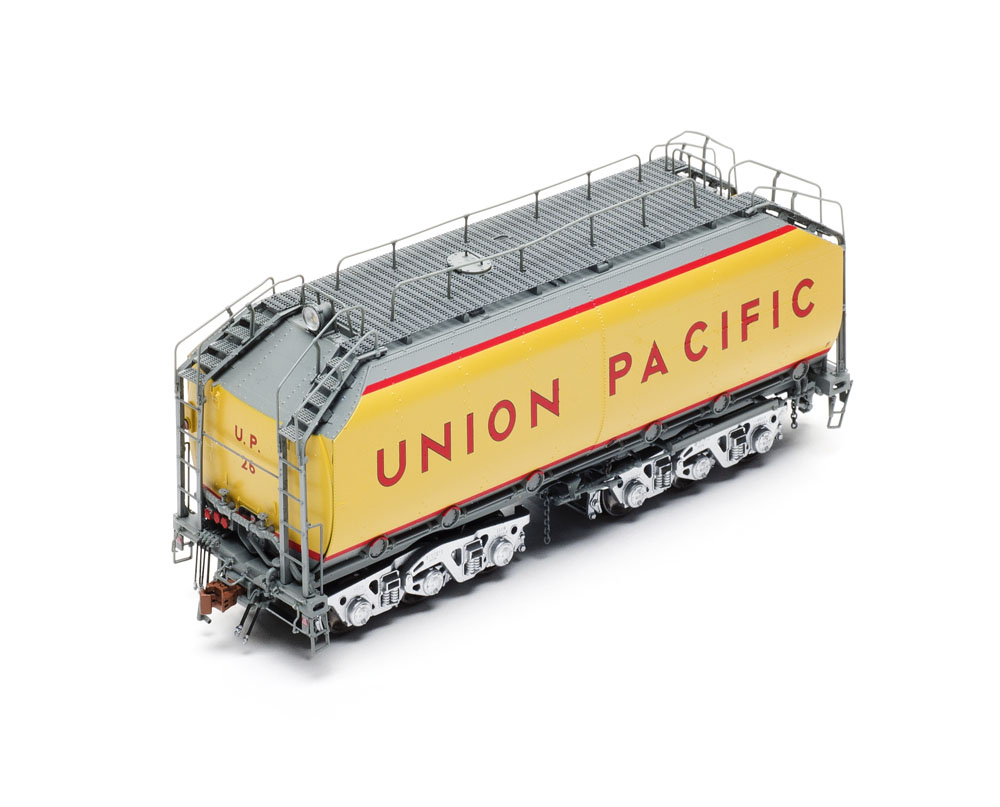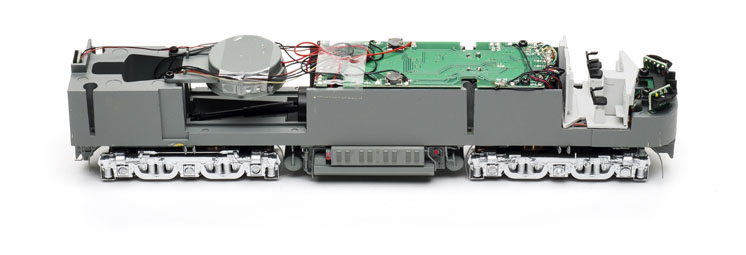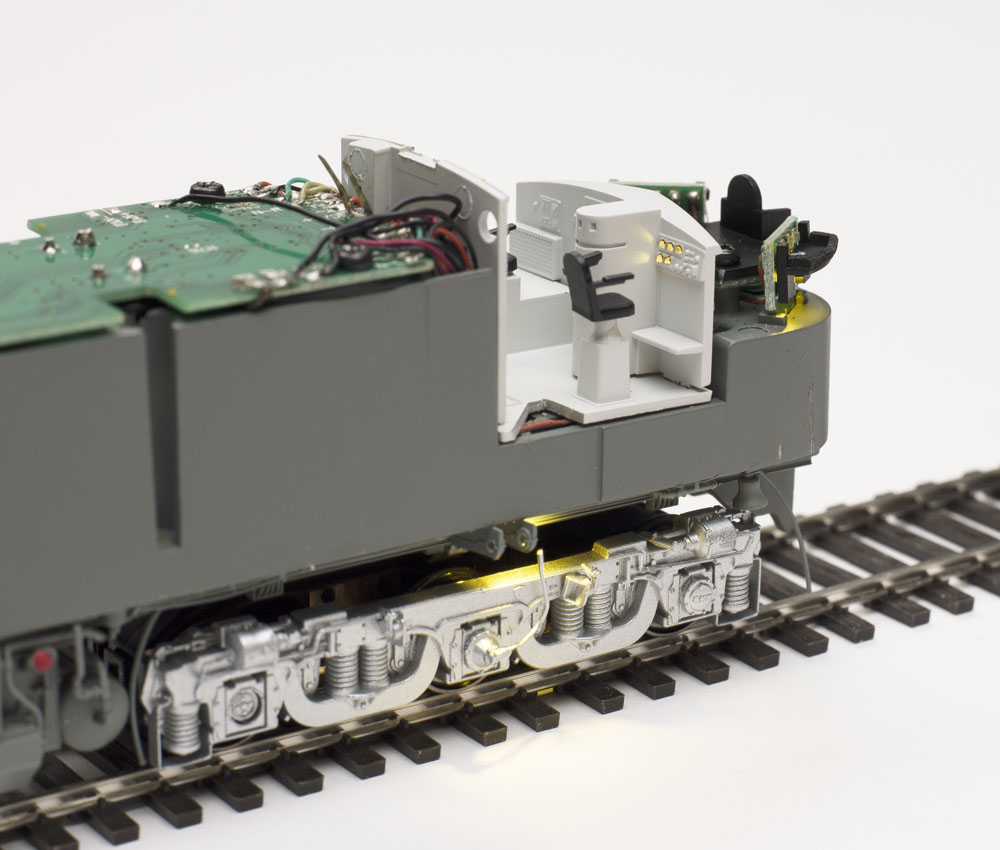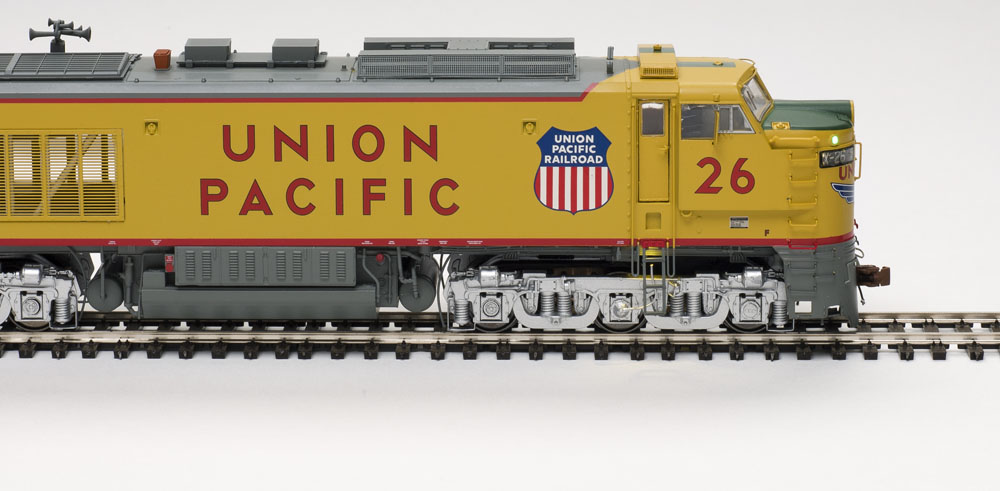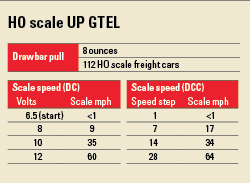With all the roadnumber-specific, superdetailed, sound-equipped models available today, the bar is set high when a new top-of-the-line HO scale locomotive comes to market. ScaleTrains.com just nudged that bar a bit higher with its Museum Quality series Union Pacific gas-electric turbine locomotive (GTEL). In addition to its scale fidelity and exquisite detailing, the model is available with a pair of ESU LokSound Select decoders that provide prototypically accurate sound, lights, and animation, including some effects never before seen on a North American scale model.
ScaleTrains.com also sells the GTEL as part of its Rivet Counter series. Although that series doesn’t include the exclusive features of the Museum Quality Series, the Rivet Counter models have accurate, road number specific detail and are available in direct-current (DC) and Digital Command Control (DCC) with sound versions.
The prototype. Double-ended, 4,500 hp gas-turbine electric locomotive (GTEL) no. 50, produced by Alco and General Electric, ushered in the Union Pacific RR’s turbine era. Instead of a diesel engine like a diesel-electric locomotive, a GTEL used essentially a jet engine to turn a generator that provided electricity for truck-mounted traction motors. This technology allowed for locomotives with higher horsepower than was possible with the diesels of the time.
Through the early 1950s GE continued building more powerful classes of GTELs for UP, culminating in the 8,500 hp “Super Turbine.” The locomotive is made up of three units: an A (control) unit, B (turbine) unit, and fuel tender. The A unit also had an 8-cylinder Bessemer-Cooper diesel engine that powered compressors and other auxiliary components. Since a turbine is extremely inefficient at slow speed, the diesel engine also served as the prime mover during hostling or when the locomotive had to maneuver through a yard. The fuel tenders for the turbine were rebuilt from retired steam locomotive tenders.
From 1958 to 1961, General Electric delivered a total of 30 Super Turbine GTELs, numbered 1 to 30, to UP. The new turbines quickly gained the nickname “Big Blows.” The UP had to ban their operation near cities and other large population centers due to the loud jet-engine whine.
The GTELs proved successful at hauling tonnage, with UP no. 1 racking up 750,000 service miles in just 5 years. However, higher-than-expected maintenance costs, the rising cost of the turbine’s once-cheap Bunker C fuel oil, and the development of more powerful diesel engines added up to an early retirement for UP’s turbine fleet. All 30 Big Blows were retired by 1970.
The model. The measurements of the ScaleTrains.com model match those of prototype diagrams reproduced in Turbines Westward by Thos. R. Lee (AG Press, 1975). Our Museum Quality Series review sample models UP no. 26, which resides at the Utah State Railroad Museum and is one of two preserved Big Blow turbines. (The other, no. 18, is on display at the Illinois State Ry. Museum.)
The plastic body shells of the A and B units and tender all feature well-defined molded details that match prototype photos of no. 26. Many of models details consist of separately applied parts. The grab irons are made of wire, while the side end ladders are made of flexible acetal plastic to resist breaking.
Just like the prototype, the etched-metal screens on the A unit allow me to look right through the body. However, one of these screens has excess glue blobs where it’s attached to the body shell.
All of the details are roadnumber specific. This includes the rooftop dynamic brake equipment on the A unit that has an “H – I” configuration, as opposed to the “H – H” configuration of earlier Super Turbines. The horn placement, above the radiator on the A unit, is also correct for no. 26.
Our review sample included some details exclusive to Museum Quality series models. The A unit’s cab doors feature separate handles and spring open to a fully detailed interior. The B unit features sliding side access doors that reveal a model of a GE turbine engine within. The fuel tender also features separately applied truck safety chains.
In addition to the molded rubber radiator hoses on the end of the A and B units, the Museum Quality series model also includes separate m.u. connections between the A and B units. However, these user-installed parts are tricky to install, and I had trouble keeping them intact when running the locomotive.
Mechanism. Like the prototype, all three units are connected by knuckle couplers. I removed the shells from the A and B units by first removing the front and rear couplers, then removing four additional screws on the bottom of each unit’s die-cast metal chassis. The A and B units each have a flywheel equipped motor that powers truck-mounted gearboxes.
Both units have DCC sound decoders plugged into 21-pin sockets on printed-circuit (PC) boards and well-enclosed 28mm round speakers. The tender features a lighting decoder that controls its directional backup light. All exterior and interior lighting on the A and B units, as well as the tender, is provided by surface-mounted light-emitting diodes (LEDs).
Performance. During testing, I ran the A and B unit together since they wouldn’t have been run separately. I tested the GTEL with an NCE DCC system. Out of the box, both units are perfectly speed matched. The excellent back electromotive force control of the ESU decoders provided smooth slow speed control even at less than 1 scale mph in speed step 1. The model’s top speed of 64 scale mph is nearly identical to the prototype’s 66 mph top speed.
Without the m.u. hoses connected the model will make an 18″ radius, but it’s really tight. The recommended minimum radius with the hoses connected is 22″. I think the model looks its best on curves of 24″ or wider.
With its 8-ounce drawbar pull, the locomotive can easily pull a prototypically long freight train. On our hill-climb test the A and B unit pulled a 36-car train plus the tender and a caboose around a curving 1.5 percent grade that led into a 3 percent grade.
The decoders also feature ESU PowerPack energy storage modules. These capacitors provide several seconds of power to keep the locomotive rolling smoothly with uninterrupted sound over dirty rails or dead spots on the track.
All the units are factory programmed. To change the road number I simply placed the A and B units and tender on our programming track and simultaneously changed the factory address of “3” to the locomotive number (26).
Like all LokSound decoders, those included with the turbine feature programmable configuration variables (CVs) that allow users to adjust sound effect volume levels, set up speed tables, map functions, and much more. Quick start instructions are included with the model but extensive LokSound user manuals are available as free downloads at www.esu.com.
Sound and lights. Pressing F8 starts up the diesel engine sounds, which play through the A unit’s speaker. The speed of the locomotive is limited to 30 scale mph until the turbine is started by pressing F3. The jet-engine whine of the turbine plays through the B unit’s speaker. On our Museum Series review sample, this function also causes the turbine blades, visible through the exhaust opening on the B unit, to spin.
There are some DCC operational features that are exclusive to the Museum Quality series model. These include an extended start up mode, which simulates the crew climbing aboard and readying the locomotive. After I pressed F8, the cab interior light comes on, then the number boards, and after a pause the interior light goes out and the instrument panel lights on the control stand illuminates. This sequence is followed by the sound of the diesel hostler engine starting. Pressing F5 triggers “NighTime Mode,” illuminating the walkway light between the A and B units and the ground light under the engineer’s side truck on the A unit. The museum series model also includes classification lights that can be toggled between white, green, red, and off with the press of a button (F6).
For me, the standout DCC features involve the wheel sensors included with the Museum Quality series A and B units. These sensors trigger flange squeal effects when each unit rounds a curve and “frog clunk” sounds when the wheels roll through a turnout or crossing. Although subtle, both effects feature a variety of sounds that taken together provide a realistic simulation of wheels on rails. It was as much fun listening to the turbine creep through a yard ladder as it was seeing it roar along the main line.
The dual-mode decoder operated smoothly on our DC test track, as shown in the performance charts above. However, the decoder’s sound functionality is limited in DC operation. The headlights operate according to direction and the turbine blades spin, but both the diesel and the turbine sounds are always on. It’s worth purchasing a starter DCC system or a sound controller such as the MRC Tech 6 to experience the unique effects available on this model.
With its custom decoder and detail that rivals any brass model, the ScaleTrains.com Museum Quality series GTEL is almost as awe-inspiring as its prototype, especially when it’s screaming down the rails.
Price: $724.99 to $774.99
(Museum Quality), $574.99 to $599.99 (Rivet Counter, DCC sound), $424.99 to $449.99 (Rivet Counter, DC, no sound)
Manufacturer
ScaleTrains.com Inc.
7598 Hwy. 411
Benton, TN 37307
www.scaletrains.com
Era: 1958 to 1970
Road numbers
18, 26, 30 (Museum Quality and Rivet Counter series)
1, 5, 7, 14 (Rivet Counter)
4, 9, 15, 21, 27 (Museum Quality)
Features
▪▪21-pin DCC socket (DC version)
▪▪All-wheel drive and electrical pickup (A and B units)
▪▪ESU LokSound Select decoders (A and B units, DCC-equipped versions only)
▪▪Five-pole skew-wound motors with dual brass flywheels (A and B units)
▪▪Light-emitting diode
▪▪(LED) illumination
▪▪Metal knuckle couplers at correct height
▪▪Minimum radius: 18″ (without hoses between units), 22″ or greater recommended
▪▪RP-25 metal wheels in gauge
▪▪Weight: 1 pound 9.3 ounces (A unit), 1 pound 5 ounces (B unit), 4.6 ounces (tender)





